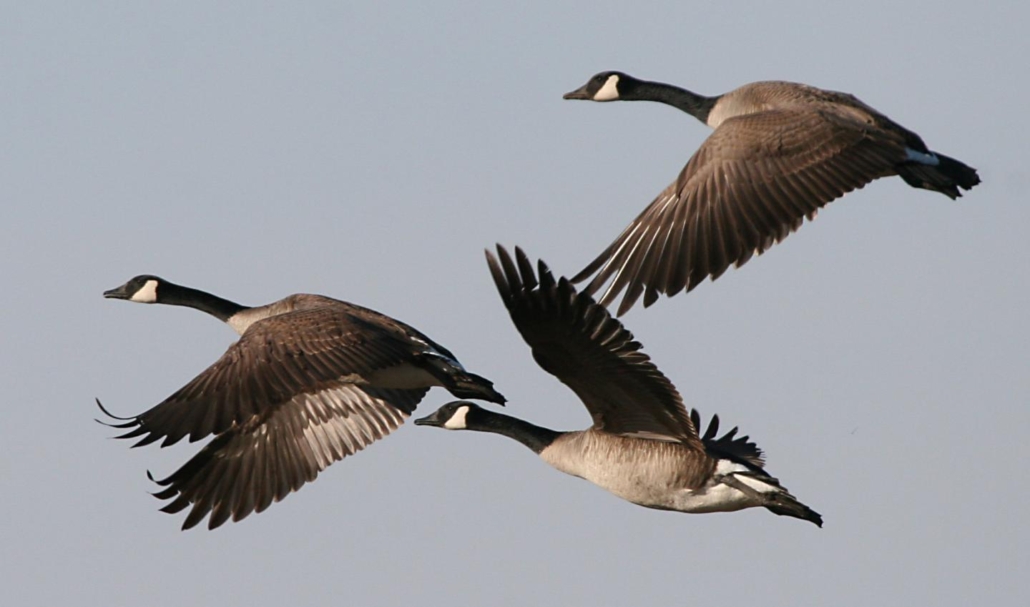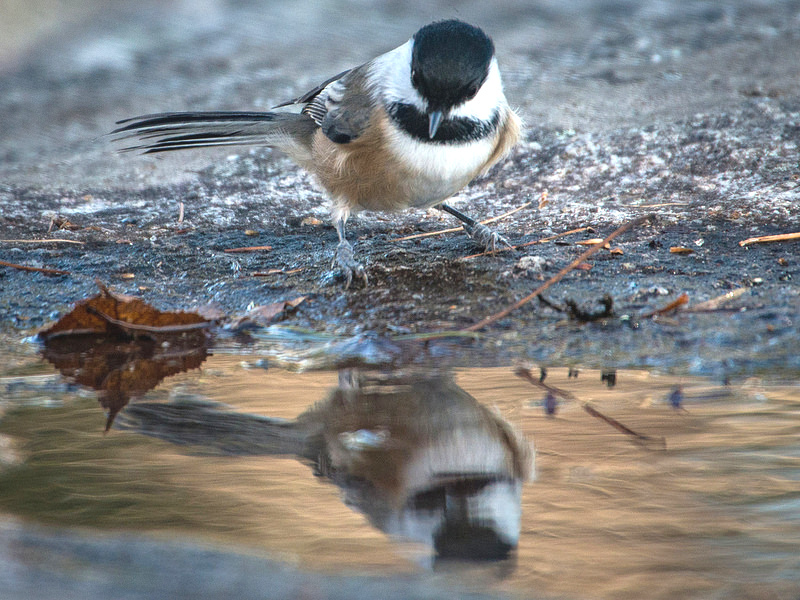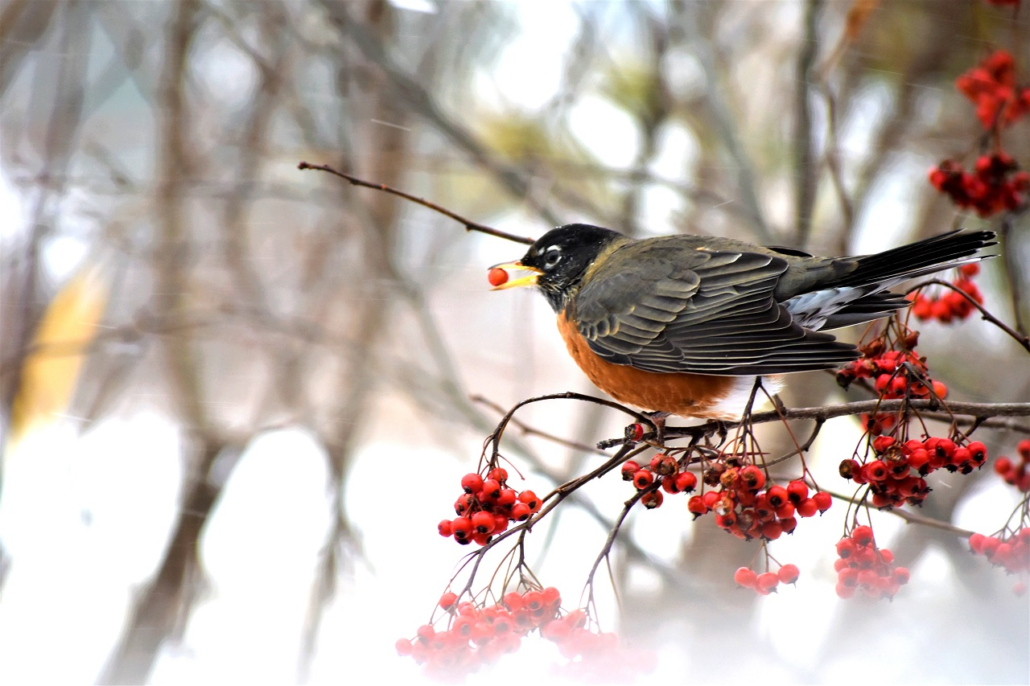Why are Canada geese flying north in December?

 by Roland D. Hallee
by Roland D. Hallee
My wife and I had a dear friend visit with us last week, and following many different conversations, she asked the question, “Why are Canada geese flying north in December?”
Interesting question.
According to the Cornell Lab of Ornithology, there are several possibilities, but in fall it’s likely these are family groups moving around, now that the yearlings can fly, in search of feeding grounds. Canada geese raise their young near water, where the goslings can feed and, if necessary, dive or swim away to escape predators. In late summer the adults temporarily become flightless as they molt their wing feathers. This usually takes about six weeks, during which the geese remain grounded. Once the young have learned to fly, and the parents have regained their flight, the whole family will take off from their nesting grounds to find more productive feeding areas – and this movement could be in any direction. This happens in the late summer before the massive southward migration as temperatures drop across the continent.
First and second year geese (not old enough to breed), along with those that lost nests early in the breeding season also undertake a molt migration. Individuals may move several to hundreds of miles during the late spring and summer to large bodies of water where they will be safer as they molt their wing feathers. In September and October many of these individuals will be returning from this seasonal journey, and again may be seen flying in almost any direction.
Also, bear in mind that there are increasingly large numbers of resident Canada geese across North America. These birds do not migrate at all, and so you may see them at any time of year flying in any direction. Their numbers have been growing exponentially since the mid-20th century and they have begun to be seen as nuisances in some communities.
Our friend noted that these geese were in their flight V formation, and there were three separate groups.
Johnnie St. Vrain, of Times-Call, states that what she may be seeing are geese that decided this is as far south as they needed to go. They probably came from further north in Canada. They’ll spend the night on a relatively large reservoir or lake where they feel safe. In the morning, they’ll fly out to whatever feeding grounds they have. They might be flying to a local park or to a nearby cornfield.
If their feeding ground is north of their roosting area, you’ll see them flying north in the morning, but you might miss them heading back south that evening.
Some of these winter geese fly in from neighboring states. Others fly down from the mountains to spend the season in front range cities.
Geese are pretty well adapted. They will fly only as far south as they need to make a living.
Historically, most Canada geese would migrate through this area, with very few sticking around. But agriculture, specifically the grain left in farmers’ fields, has caused geese to spend winters here.
The geese that fly north-to-south in fall are less noticeable. They fly a couple thousand feet high.
But locally, large numbers of geese will sit out on a lake. Their warmth will keep the water open. The geese might move when we’ve had really cold weather and a lot of the lakes around here ice up and become unavailable. But we have enough warm days, that if there’s enough geese hanging out, it will create holes they can stay in. Or they’ll stay on the river, but they don’t like that as much.
Our friend lives on the river in Fairfield, probably why she sees these flocks of Canada geese flying north. There are many cornfields north of Fairfield.
It may be worth paying a little more attention to see if they return at night.
Roland’s trivia question of the week:
The New England Patriots have appeared in 10 Super Bowls, the most in NFL history. Name the three teams that are next with eight appearances each.


 by Amy Messier
by Amy Messier





 (NAPSI)—Americans are officially abandoning attempts to be healthy until 2019, according to a new study.
(NAPSI)—Americans are officially abandoning attempts to be healthy until 2019, according to a new study.
 by Marilyn Rogers-Bull & Percy
by Marilyn Rogers-Bull & Percy



 On a weekend day after Thanksgiving our family always went on the Christmas Tree Walk. Naturally, Dad had done hours of walking throughout the year and he knew where he was walking his Christmas tree hunters this year.
On a weekend day after Thanksgiving our family always went on the Christmas Tree Walk. Naturally, Dad had done hours of walking throughout the year and he knew where he was walking his Christmas tree hunters this year.
 “The unfortunate reality is that rural Americans routinely have to travel long distances for cancer care, which can lead to dangerous delays in their diagnosis and treatment,” said ASCO President Monica Bertagnolli, M.D., FACS, FASCO. “As a result, rural counties have higher death rates from many common cancers than urban areas. Our health care system needs to address these disparities so that every patient, no matter where he or she lives, can access high-quality cancer care.”
“The unfortunate reality is that rural Americans routinely have to travel long distances for cancer care, which can lead to dangerous delays in their diagnosis and treatment,” said ASCO President Monica Bertagnolli, M.D., FACS, FASCO. “As a result, rural counties have higher death rates from many common cancers than urban areas. Our health care system needs to address these disparities so that every patient, no matter where he or she lives, can access high-quality cancer care.”
 With the demise of the old Killdeer Lodge recently, which over the years had fallen into disrepair, the following article represents a history of the lodge, from its inception in 1929, to the razing in 2018.
With the demise of the old Killdeer Lodge recently, which over the years had fallen into disrepair, the following article represents a history of the lodge, from its inception in 1929, to the razing in 2018.